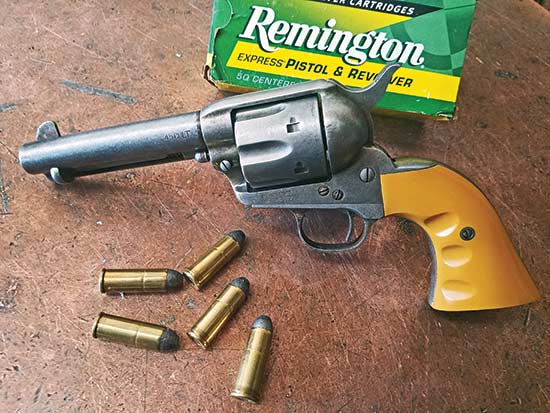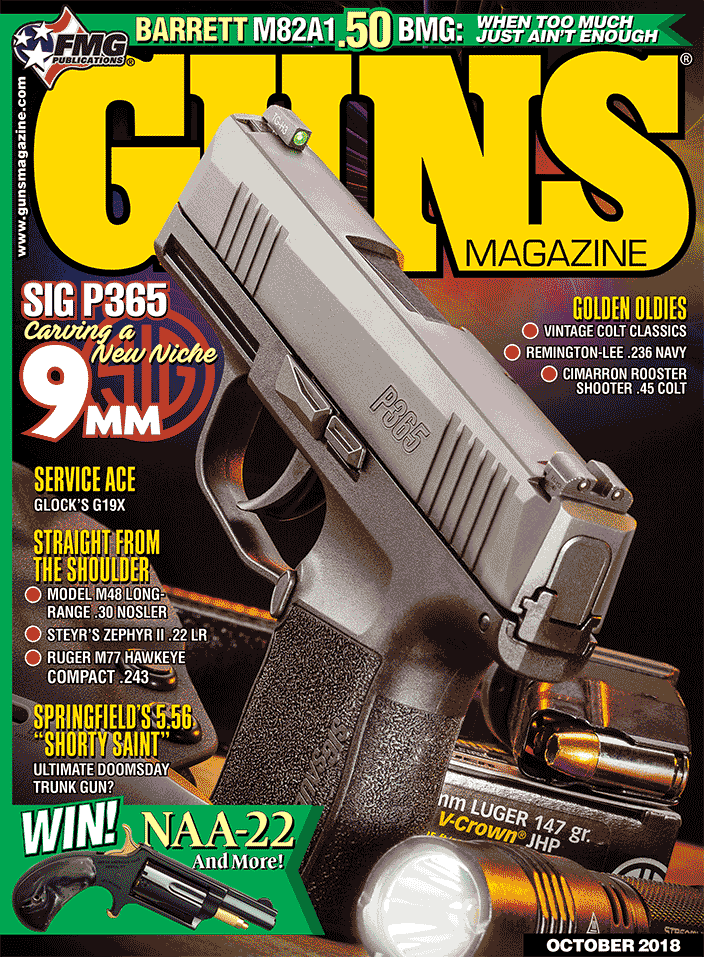A Return To Single Life
It’s All About The Action
Okay, full disclosure: I didn’t grow up shooting Colt Single-Action Army models of any generation. By the time I was old enough to thumb-crank a hammer back, it was pretty much Rugers for me. Although in all fairness, most were “pre-transfer-bar” Single-Sixes and Blackhawks I could set at half-cock, flip open the loading gate, spin the cylinder, treat ’em as “5-shooters” and still feel kinda like, well … John Wayne (or at least Duke’s great cinematic nemesis, Richard Boone).
But I always did love the idea of a 4-3/4″ flat spring, fixed-sight SAA with a hammer-mounted firing pin and what collector types refer to as “patina.” In other words, I lusted after the one with the rearing pony on the grip medallion. The older the better. During the first half of my shooting lifetime, however, I saw new Colt SAAs ascend the MSRP ladder from $125 to over $1,500. And at every rung they were still tantalizingly out of my reach — when they were available that is.
By the time I might’ve been able to make the nut, Cowboy Action was in full swing. Ahh, I thought. This looks like a whole lotta fun. Maybe the time is now . . .
I mentioned it to a buddy of mine who shot Cowboy matches religiously, had his Wild West alias up and running and had succeeded in convincing his better half to dress up like a frontier saloon wench for club events and get-togethers.
“What!” He looked at me like I was crazy. “You’re gonna beat up an investment Colt? You don’t know how much ammo we go through! Even with powder-puff Cowboy loads you’ll be seeing dollar bills sprout wings and fly away with every shot. Get a Ruger Vaquero or a good import clone.” So I let the matter drop and went back to shooting Smith K-Frames, Ruger anythings, 1911s, polymer 9mms and whatever else I could lay hands on.
But I did console myself by toting up Arguments Against: (1) A lock time measurable with a sun dial. (2) Reloading time? Better bring a lunch. (3) The roll-back with those plowshare grips? Who needs it?
Still, I Wanted One
And still there was the great Inflation Argument For: An 1880s cowboy could get a Peacemaker for a 20-dollar “Double Eagle” gold piece. A 1990s Cowboy Action shooter could too. Provided he had the money equaling the value of said Double Eagle — if not the gold itself. How’s that for across-the-board economic fairness through the decades?
Years passed and the desire faded into the shadows. Well, kind of. At the last SHOT Show, something caught my eye as I passed the Cimarron booth display case. My initial thought? What’s that worn-out old original doing with all those pretty nickeled, case-colored and charcoal-blued SAA imports? Turns out the model was the Rooster Shooter. It features yellowed faux ivory stocks, some serious pewter-gray patina and a 4-3/4″ barrel. The caliber was .45 Colt.
It looked exactly like what the Duke packed in True Grit and Rooster Cogburn (which explains the name). I pulled the hammer back and heard the four magic clicks that spell out C-O-L-T. It’d been in production for several years, but my single-action desire had been dormant since the turn of the century, so I missed much of the commotion it stirred up. But now I got interested.
I could hardly wait to get one out to the range after first scrounging around for .45 Colt ammo, being careful to exclude anything rated for big Rugers or Freedom Arms single actions.
Loads used included 225-gr. Winchester Silvertip and Supreme Bonded JHP (807 and 848 fps respectively), 255-gr. Buffalo Bore Standard Pressure (939 fps) and Remington 250-gr. Lead RNFP (789 fps).
Standard pressure or not, the Buffalo Bore stuff was the thumper of the lot and represents the top end of anything I’d want to try out of any 1873 Colt — clone or original. From a 5-1/2 or 7-1/2″ barrel, this stuff would be even “awesomer.” The tightest group was from the Remington 250s (which is as close to the original loading as we had), but the gun threw them low and a bit left at 25 yards.
I’m pretty fond of the Rooster Shooter. The current .45 Colt chambering is all aces with me. But I have a hunch our more dedicated SAA guys might want other frontier chamberings. What purists! Imagine . . .
Okay, .38-40 sounds pretty good to me.
Less-Shocking Option
Mossberg’s 590 pump Shockwave series hit the marketplace a year or so ago with a 12-gauge, then a 20. Then at the 2018 NRA get-together in Dallas, the company premiered a .410 version. With a weight of around 4 lbs. and an overall length of just over 2 feet, this handy stockless repeater might be the slickest little special-purpose .410 since the late, lamented Snake Charmer.
For short-range pests or hazardous creatures of the reptilian persuasion, about any birdshot load would be fine from the Cylinder Bore 14″ barrel. But the possibilities don’t stop there. Federal’s Personal Defense 3″ 000 buck load features five, .35-caliber pellets. And Winchester’s Super-X 3″ slug load features a quarter-ounce lead HP at around 1,800 fps. We’ve shot, grouped and patterned these two bad boys previously. And after doing so, I really don’t feel up to disrespecting the .410. No way. MSRP on Mossberg’s littlest Shockwave is $455.







